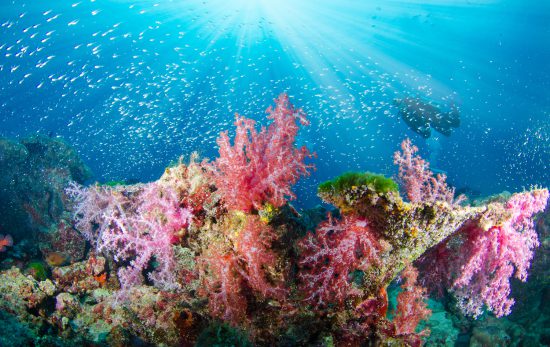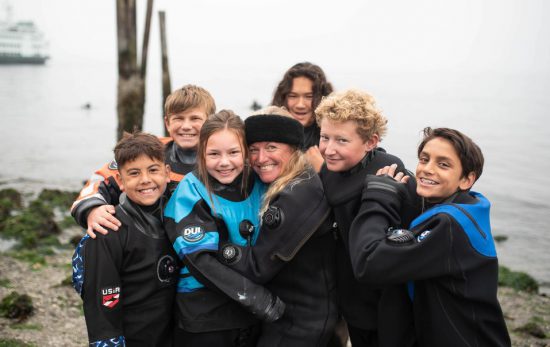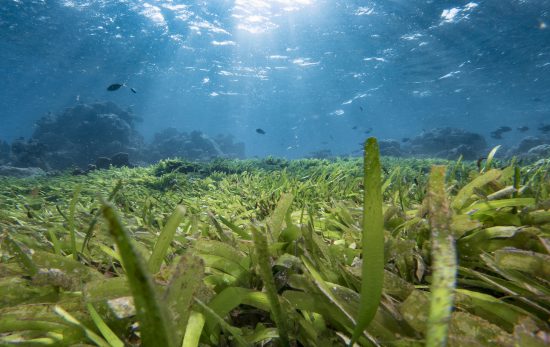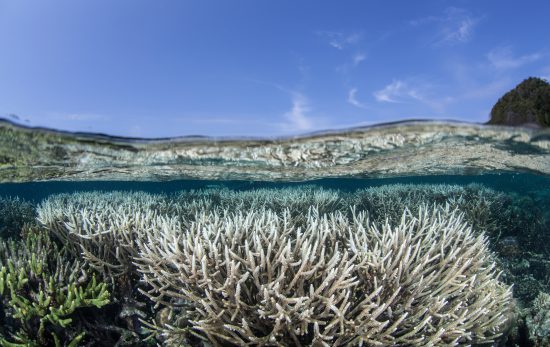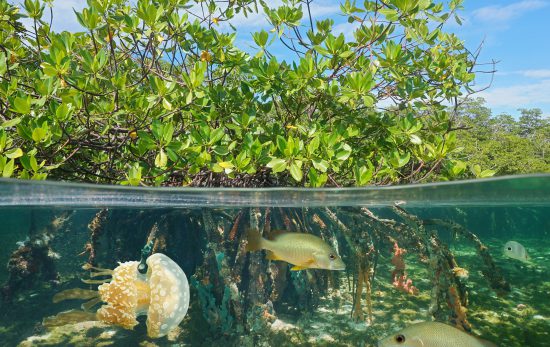As underwater-enthusiasts, we’ve each fallen in love with the ocean in our own unique way; whether it was an unforgettable whale shark encounter, a moment of peace hovering in light-filled coral shallows or that first night dive where bioluminescence transported you to a space-like glowing wonderland.
As the sub-aqua pioneer Jacques Cousteau noted, ‘people protect what they love’. And let’s be honest, the ocean has never needed our protection more than it does today.
A major component in ocean protection is the fight against climate change and ocean acidification. In many ways, it is THE fight, as conditions in the ocean dictate whether or not our beloved marine species can survive – from the smallest crustacean, to the mammoth Great Barrier Reef.
It’s all connected, and we all have a part to play in driving meaningful change.
Still not sure exactly how climate change effects the ocean, or what you can do about it? No worries, you are not alone, and you’ve come to the right place for answers.
First things first, how does climate change even effect the ocean?
Essentially, when we burn fossil fuels, we release carbon dioxide into the atmosphere. A large portion of this carbon dioxide is absorbed by the ocean, and this changes the composition of the water, creating hostile conditions for sea life.
The solution? Reduce the amount of carbon dioxide floating around in the seas.
The good news? Whales, seagrass meadows, mangroves and salt marshes all act as incredible, 100% natural means of carbon sequestration and storage. But that’s just one side of the coin. We all need to look at our own emissions and think about changes we can make in our daily lives that reduce the amount of carbon we are personally pumping out into the atmosphere.
And no, you don’t have to give up all that is fun in the world to achieve this. Seriously. Whoever told you sustainable living was life-limiting just didn’t understand all the options. I promise.
Keep reading for 25 ways you can reduce your carbon footprint and do your bit to save the ocean…
1. Become a flexitarian
Reducing the amount of meat and dairy in your diet is one of the most powerful changes you can make in terms of reducing your carbon footprint. To do your part, you don’t need to give up meat for good. Explore the concept of Flexitarianism and consider joining in with the global Meat Free Monday movement.
2. Plan your weekly shop
In the United States, food waste is estimated at between 30-40 percent of the food supply. That means we’re generating emissions associated with the production, processing, transportation, preparation, storage, and disposal of discarded food – for nothing. Planning your weekly shop allows you to reduce your food waste, with the added perk of hassle-free mid-week cooking and the chance to try some tasty, new recipes.
3. Eat seasonal and local
A significant portion of the emissions associated with our diet can be attributed to food miles. That is, the distance produce needs to travel before it reaches your plate. Discover what’s available in your area by exploring the local farmers market, or sign up for a vegetable box scheme.
4. Grow at home
The best way to reduce food miles? Grow your food in your garden! Even if all you have is a small terrace or balcony (or even just a window shelf in the kitchen), there is produce you can grow at home to supplement your diet. You won’t find anything fresher than that! Plus, it’s a fun project for kids.
5. Stop drinking bottled water
Bottled water often travels a long way before it reaches you, you have to pay for it and you end up ingesting a scary amount of plastic – and that’s before you even think about what happens to your bottle once you’re done with it. Avoid contributing to the emissions associated with the manufacturing, processing, transportation and storage of bottled water, by opting for tap water. It’s literally free and pumped directly into your home. If you’re concerned about quality, consider a filter tap.
6. Drive less, cycle more
Ask yourself if you really need to drive next time you head out of the house. This awful pandemic has given us a taste of what life could be like with less cars on the road, and across-the-board improvements in air quality have been a welcome breath of fresh air for us and the planet. Get on your bicycle – it’s good for the planet and your health too!
7. Drive a low carbon vehicle
If you live somewhere that means your car is a necessity, then it’s worth looking into low carbon options. Electric vehicle technology is improving at a rapid speed, and this is bringing down the prices. Granted, it may not be affordable for everyone – yet – but if it is, it’s something worth seriously considering.
8. Stay pumped
When you absolutely need your car but you can’t afford to go electric, there is still something you can do – keep your tyres pumped. Tyres at optimum pressure make your vehicle as efficient as possible, as your engine doesn’t need to work as hard to push itself forward. That means less gas is used, fewer emissions are released, and your wallet will thank you too.
9. Switch to 100% renewable
These days, there are a growing number of energy providers that can offer 100% renewable sources. Do your research, then make the switch. It’s easy as that and you won’t have to think about it again. Plus, you’ll have earned that warm fuzzy feeling that comes with knowing you’re supporting a sustainable future for generations to come.
10. Unplug your devices
Did you know that our devices continue to suck up energy from the socket, even when they are not in use, or even turned on? I didn’t – until recently. By 2023 the average home is expected to have almost 20 connected devices, and the total cost of standby energy across the country can amount to tonnes of CO2 and other greenhouse gases being emitted.
11. Explore local
Ah, the staycation. Enforced upon us by Covid-19, but actually surprisingly awesome. Check out what’s available in your region, book a quirky local getaway or act like a tourist in your own city. The result? Maximum fun and excitement, with zero queuing at the airport, or long, arduous plane journeys. You’ll likely be saving money too, so you’ll have no excuse but to treat yourself to that extra slice of cake or glass of prosecco.
Download the PADI Adventures App and discover diving activities in your local area!
12. Fly direct
Ok, I admit it. As divers, we all want to explore the world in search of those unforgettable marine life encounters. And almost exclusively, this means air travel. But did you know that the majority of emissions associated with flying are attributed to take off and landing? That means – in addition to reducing the number of flights you take and offsetting your emissions – you can also cut the amount of carbon released by booking direct flights.
13. Channel your pension for good
Odds are, unless you have actively opted into an ethical pension fund, your pension is invested in the very organisations that are fuelling the climate crisis. Do your research, and make the switch. It’s a small change that we can all make that together will bring about massive change.
14. Mend and lend
Think twice about throwing your stuff away when it’s ‘broken’. Repair cafes are popping up all over the western world, and if there’s no one nearby that can help you, there is always YouTube.com. If you need something you don’t have, before buying it yourself, consider whether a friend, family-member or neighbour might be able to lend it to you. It’s free, and another chance to socialise with your community.
15. Buy it used
When you can’t mend what you have, or borrow what you need, consider a second-hand purchase. Often, second-hand goods are just as good as new, with the added benefit of being half the price. Plus, they might come with additional character and beautiful imperfections, described best by the Japanese phrase ‘Wabi-Sabi’.
16. Buy once
When you absolutely need something new, make sure you purchase long-lasting, well made products that are designed to endure. Over the past few decades, manufacturers have cottoned on to the fact that poorly-made products that break quickly both cost less to make, and drive more business their way when you need to replace that item, again. This is called ‘planned obsolescence’. Look out for brands that place durability at their core, and spend a little extra on quality. It’ll pay off in the long run, and is better for the environment too!
17. Recycle
This one’s a classic. When you’re done with something that can’t be re-used, it’s best to recycle. Absolutely, our recycling infrastructure has a long way to go, but the more we as individuals turn our attention to the full life-cycle of our products, the more likely it is we will see improvements to reflect this. There’s already loads of companies selling products made entirely from recycled materials – very cool!
18. Insulate, insulate, insulate
The first step in making a building climate-friendly is to reduce its energy loss. With greater insulation comes reduced energy loss, meaning less energy is required to maintain a pleasant temperature at home. This means making sure your windows all close properly, sealing any drafty areas and enlisting the help of a professional to insulate your home if there are problems that you cannot fix on your own.
19. Maintain your cool (and heat!)
Keeping your cooling and heating systems in good shape (according to the manufacturers instructions) will reduce the amount of energy that is used to achieve the same effect. Plus, it’ll mean they last longer, saving you time and effort in the long run.
20. Reduce your water use
Limit those long, luxurious showers and baths to once a week, or opt for water-efficient appliances that seem to do the work for you. Set up drip-irrigation in your garden, or choose to wash your clothes less often (did you know, jeans actually last longer when they aren’t washed as often?). There are various ways you can reduce your water use, and you don’t need to implement all of them. Think about your values and lifestyle, and opt for the strategies that suit you.
21. Go retro
Second-hand clothing is a winner for two (maybe three) reasons: it’s more affordable, it’s more stylish and in some cases it even lasts longer. Raid your parents or grandparents attics for classic 80’s garms, rifle through your neighbourhood thrift store or head to the local charity shop to pick up a bargain.
22. Soft and sustainable
Sometimes, you need something really specific, or a closet staple that you simply can’t find at the thrift store. This is the time to look into sustainable clothing companies, who have ethical standards meaning they produce soft, long-lasting clothing in an environmentally-friendly way. Yes, the price is a little higher than usual, but the items will last longer, and we all have to appreciate the real cost of clothing production. Plus, you’ll have saved so much by hitting up the thrift store, that you’ll have extra cash in the clothing budget just for this.
23. Thoughtful gifting
Christmas and birthdays are always a time for excess waste, and waste = needless carbon emissions. Opt for biodegradable wrapping paper, and think about what your friends and family really want. If you’re not sure, ask them. Consider donating to charity on their behalf, or opting for an experience they can enjoy with you rather than stuff they may not want or need, that’ll end up in landfill.
24. Get creative
Rather than turning on the TV, games console or computer (or ordering a take away out of boredom), entertain yourself and your family with a creative endeavour. Whether that’s baking, sewing, painting, wood work, gardening or something else entirely, nothing beats the feeling of accomplishment that comes from making something with your bare hands. You could even get creative by upcycling old furniture items, thereby reducing your waste, creating memories with your friends and family, and – ultimately – saving you money.
25. Surf the web
Yes, you read that right. You can reduce your carbon footprint by surfing the web. Earthly features beautiful imagery of our planet, curated daily tips, news and recommendations about the environment and climate change. Most importantly, it offsets CO2 every time you open a new browser tab, simple as that. Start now, it’s free!

